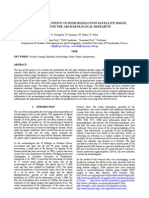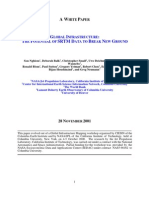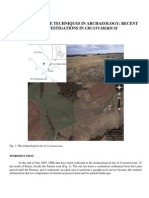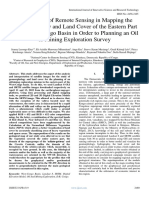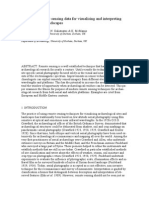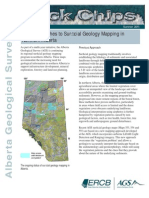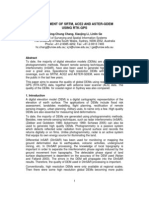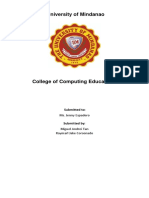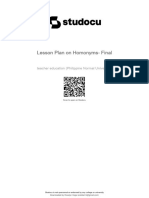Sauerbier Lambers 2003
Sauerbier Lambers 2003
Uploaded by
Nill SalunkeCopyright:
Available Formats
Sauerbier Lambers 2003
Sauerbier Lambers 2003
Uploaded by
Nill SalunkeOriginal Description:
Original Title
Copyright
Available Formats
Share this document
Did you find this document useful?
Is this content inappropriate?
Copyright:
Available Formats
Sauerbier Lambers 2003
Sauerbier Lambers 2003
Uploaded by
Nill SalunkeCopyright:
Available Formats
International Archives of the Photogrammetry, Remote Sensing and Spatial Information Sciences, Vol.
XXXIV-5/W10
A 3D MODEL OF THE NASCA LINES
AT PALPA (PERU)
M. Sauerbier, K. Lambers
Institute of Geodesy and Photogrammetry
Swiss Federal Institute of Technology Zurich
ETH Hoenggerberg, CH-8093 Zurich, Switzerland
www.photogrammetry.ethz.ch
(sauerbier, lambers)@geod.baug.ethz.ch
Commission V, WG V/6
KEY WORDS: Archaeology, Acquisition, DTM, Mosaic, Vector, Visualization, Analysis
ABSTRACT:
The Nasca Lines or geoglyphs in the desert of south Peru are among the most famous cultural heritage sites in the world.
Unfortunately, their investigation and interpretation has been hampered for a long time by the lack of an accurate documentation.
Based on aerial imagery that was especially acquired for this purpose, we produced a virtual 3D model of the northern part of the
Nasca region, around the modern town of Palpa. The slopes and ridges of this area are covered by more than 1500 geoglyphs that
are shown in the model. This 3D model of Palpa, presented at the workshop for the first time in its complete form, is the result of 5
years of archaeological and photogrammetric fieldwork at Palpa jointly conducted by geodetic engineers of ETH Zurich and
archaeologists from Germany and Peru. The model consists of a DTM, photorealistic texture based on an orthomosaic, and a vector
layer showing the geoglyphs. These high-resolution datasets are needed to ensure accurate results of the intended archaeological
analysis. The overall file size of the 3D model is about 3 GB. Such an amount of data could not be visualized in real time until
recently when more powerful hard- and software became available for PC systems. For the Palpa model we use Skyline by IDC,
Switzerland, to visualize the terrain and the geoglyphs. The advantages and shortcomings of this software are discussed in the
present paper. Furthermore, the use of the 3D model as a valuable tool for archaeological research is described.
1. INTRODUCTION
On the south coast of Peru, the Ro Grande de Nasca and its
tributaries crosscut a vast plain at the foot of the Andean
mountains that forms part of one of the driest deserts in the
world (Fig. 1). The slopes and plateaus between the fertile river
oases of the Nasca region are covered by a spectacular
conglomerate of ground drawings of pre-hispanic origin,
commonly known as Nasca Lines or Geoglyphs. The drawings
or carvings, which were made by removing the upper level of
darkly oxidized stones to expose the brighter sandy level below,
show a wide variety of sizes and forms: straight and zigzag
lines, large trapezoids and rectangles, and biomorphic figures.
Though enlisted as World Cultural Heritage by UNESCO in
1994, the meaning of the Nasca Lines is still largely
unexplained. Only their cultural affiliation has been reliably
established: while the first geoglyphs date to around 400 BC
(Paracas Culture), most of them were made during the time of
the Nasca Culture (approx. 200 BC to AD 600) (Silverman,
Proulx, 2002; Reindel, Lambers, Grn, in press). A culturalhistoric interpretation of the Nasca Lines is fraught with
difficulties, since so far only a few important geoglyph
concentrations have been documented in detail, whereas the
vast majority of lines and figures remains unrecorded. Any
effort to map the geoglyphs by traditional means usually
available to archaeologists (like theodolite and measuring tape)
faces serious problems, like e.g. the hardly accessible terrain,
the sheer number and size of the geoglyphs, and their poor
visibility on the ground. Thus, it comes as no surprise that most
available maps of the Nasca Lines are of poor quality and show
only a small fraction of the existing geoglyphs. Moreover, the
topographic maps of the region lack the required accuracy, too.
Without a good documentation, however, any attempt to explain
the use and the function of the geoglyphs within their cultural
context is conjectural, since the hypothesis cannot be tested
against a reliable dataset.
In 1997, ETH Zurich, the German Archaeological Institute
(KAVA, Bonn) and the Andean Institute of Archaeological
Studies (INDEA, Lima) jointly started a long-term
interdisciplinary research project with the aim to record,
investigate and interpret the second largest geoglyph
concentration in the Nasca region around the modern town of
Palpa. More than 700 archaeological sites were registered, and
extensive excavations were carried out at several Nasca
settlements (Reindel, Isla, 2001; Reindel, Isla, Lambers, 2002).
To record the Nasca Lines, well established photogrammetric
procedures were applied for the first time in Nasca archaeology
in order to generate a 3D model of the Palpa region and its
geoglyphs (Grn, Lambers, in press; Grn, Sauerbier, Lambers,
in press). To be useful for archaeological analysis, the 3D
model had not only to cover a large area (90 km2) in high
accuracy, but had also to come with high resolution
photorealistic texture (0.25 m footprint) in order to show the
archaeological remains in detail. These requirements resulted in
a vast amount of data that only recently became processable and
visualizable at reasonable cost. In this paper we present the 3D
model, discuss its visualization, and show how we use it for
archaeological analysis that is hoped to allow new insights into
the function and meaning of the geoglyphs.
International Archives of the Photogrammetry, Remote Sensing and Spatial Information Sciences, Vol. XXXIV-5/W10
Figure 1: Overview of the area of investigation
2. DATA ACQUISITION AND PROCESSING
2.1 Acquisition of aerial images
The investigated area around Palpa is located about 400 km
southeast of Lima, around 60 km inland (Fig. 1). Several rivers
(Ro Grande, Ro Palpa, Ro Viscas, from north to south)
transect the landscape. Their valleys delimit two arid ridges or
plateaus, resp.: the Cresta de Sacramento (to the north of Palpa)
and the Pampa de San Ignacio (to the south) on which the
largest concentration of geoglyphs outside the Pampa de Nasca
(further to the south) is found. As a prerequisite for a complete
recording of the more than 1500 geoglyphs and for the
generation of an accurate terrain model, we had to do a special
photoflight due to the lack of accurate maps and suitable aerial
imagery of the region. Older aerial images taken in the years
1944 and 1970 by the Peruvian SAN (Servicio Aerofotogrfico
Nacional, Lima) do exist, but cover mainly the valley floors and
only a few geoglyphs along their margins. Thus, they are not
suited for a complete recording; rather, their main value is to
show that many geoglyphs have been damaged in the last
decades. In order to acquire images suitable for
stereoprocessing, during a photoflight in May 1998 over the
two blocks of Sacramento and San Ignacio (Fig. 1) 384 images
(B/W) were taken using a ZEISS RMK A 15 camera (Grn,
Beutner, Br, 2000; Grn, Lambers, in press). The image scale
is approx. 1 : 7000, large enough to discern even the narrowest
lines with a width of about 10 cm. The photoflight was done so
that an overlap of 60% resulted in both directions. Between the
two neighboring strips of the parallel blocks there is an overlap
of max. 20%, decreasing in northeast direction. Approximate
coordinates of the projective centers were measured using
kinematic GPS on board and corrected during postprocessing
using data of a reference station. Two kinds of ground control
points were used: 8 signalized points in Sacramento and 9
natural points in San Ignacio. The control points were measured
with Differential GPS (Grn, Brossard, 1998). The GPS
coordinates were then transformed from WGS 84 to the
Peruvian system (UTM Zone 18).
2.2 Aerotriangulation
The success rate of automated image matching depends on
different factors (Grn, Zhang, 2002). In the case of the aerial
images of Sacramento and San Ignacio, the most influential
constraint in this regard was the lack of texture caused by the
homogeneous desert surface. Therefore, after tests using
automated image matching had not yielded the theoretically
possible accuracy of 0.2 m RMS for manual measurements of a
single point (Grn, Br, Bhrer, 2000), the aerotriangulation of
the images of both blocks was done manually on an analytical
plotter Wild S9. Thereby, a global accuracy of s0 = 13.3 mm for
Sacramento and of s0 = 9.5 mm for San Ignacio was achieved
(Grn, Lambers, in press).
2.3 DTM measurement
To obtain a highly accurate Digital Terrain Model (DTM) suited
for archaeological and topographical analyses, the DTM
measurement had again to be done manually on an analytical
plotter due to the lack of sufficient texture (Grn, Lambers, in
press). The result was a DTM with a mesh size of 2 m covering
International Archives of the Photogrammetry, Remote Sensing and Spatial Information Sciences, Vol. XXXIV-5/W10
an area of approx. 90 km2. For grid calculation we used DTMZ,
an interpolation software developed at IGP that performs
Delauney triangulation and finite element interpolation. After
the DTM measurements were completed, we merged the data of
both blocks to obtain a single DTM for the whole Palpa area.
Due to the limitations of DTMZ concerning the number of
points, the complete data set could not be processed at once, but
instead had to be divided into 8 parts which were interpolated
separately. Then, the grids were merged using an ArcView
script applying the Grid.Mosaic function. The file size of the
DTM is about 720 MB.
2.4 3D vector measurement
For a meaningful analysis of the geoglyphs it was necessary to
achieve a complete and accurate recording, which again had to
been done manually on an analytical plotter. This step resulted
in about 20 MB of 3D linear vector data representing the
margins of the geoglyphs. The vector data was measured using
the XMAP software by Aviosoft and afterwards transferred to
DXF- and ArcView-shapefile format for further processing, e.g.
for the production of analog maps for archaeological fieldwork.
The measurement of the geoglyphs was a complex procedure
requiring archaeological expertise in order to map the cultural
remains correctly. The problems encountered during the
mapping process were manifold: many lines are discontinuous
due to erosion, a lot of geoglyphs cut or cover others, and in
some cases it is difficult to decide whether a line is a footpath or
a geoglyph. Therefore, the measured vectors had to be verified
and corrected during 3 field campaigns in Palpa (Reindel,
Lambers, Grn, in press). Furthermore, in a separate 3D-vector
data set we also mapped topographic objects like rivers, roads,
buildings, and modern geoglyphs in order to get a complete
documentation of the current state of the Palpa area. The file
size of the vector data of the modern elements is about 30 MB.
2.5 Orthomosaic
The orthomosaic was generated on a LH Systems DPW 770
digital photogrammetric station after the aerial images had been
scanned on an AGFA Horizon scanner at IGP and a ZEISS
SKAI scanner at the Federal Office of Topography, Wabern,
Switzerland, resp. The scanning was done with a resolution of
21 mm corresponding to a footprint of 0.15 m on the ground.
The orthomosaic (2.2 GB) covers approximately the same area
as the DTM with a footprint of 0.25 m. It is not only used for
visualization purposes, but also for the process of object
definition, in which we build 3D polygonal objects from the
measured linear vectors (Sauerbier, Lambers, forthcoming).
quite limited concerning the size of the data set. Nevertheless
we use it for the production of still images (Fig. 3; see also
examples in Reindel, Lambers, Grn, in press; Grn, Sauerbier,
Lambers, in press). A real time navigation through the complete
3D model is not possible using the ERDAS system. As an
alternative we visualized the Sacramento part as well as the San
Ignacio part transformed to Open Inventor format on an SGI
Onyx 2 computer with the SceneViewer and Perfly tools.
Unlike ERDAS or Skyline (see below), these tools do not use
the Level of Detail technique to partly reduce the resolution of
the model but instead render the complete model in its original
resolution. To come close to real time performance, the
resolution of the DTM had to be reduced to 20 m, so these
models could only be used for overviews since details were not
recognizable in acceptable quality. The advantage of
SceneViewer is its capability to display 3D models in stereo
mode, which allows observers to get a spatial impression. One
of its main disadvantages is the missing option to display vector
data.
3.2 Skyline
Currently, for real time visualization of the complete 3D model
we use the Terra Explorer Pro / Terra Builder software package
by Skylinesoft, distributed in Switzerland by IDC AG, Luzern
(Skyline Software Systems Inc., 2001). The Skyline software
was chosen because it is one of the first visualization packages
that runs on conventional PC architectures even with large
datasets in real time mode. Furthermore, unlike with most other
products in this segment, the user is able to generate and edit
the 3D model on his own without depending on the service of
the software distributor. In general, the requirements of the
Nasca-Palpa and other IGP projects are largely met by the
Skyline software package. It is to be expected that most of the
problems encountered during our work (described below) will
be resolved with future versions of the program.
The Terra Builder is used to import the data (DTM,
orthomosaic, vector data) and to render the textured 3D model.
Table 1 shows the data formats and some further technical
features of the Terra Builder.
Feature
Coordinate
Systems
DTM
Formats
3. VISUALIZATION OF THE 3D MODEL
The 3D model of the Palpa region consists of the DTM, the
orthomosaic texture, and the vector data, all in all about 3 GB
of data. During the past few years we generated several
visualizations of preliminary or partial data sets with ERDAS
IMAGINE Virtual GIS (still images) and Open Inventor on SGI
(flyovers). Currently, we employ Terra Explorer by Skyline for
real time visualization of the complete 3D model.
3.1 ERDAS IMAGINE Virtual GIS, Open Inventor on SGI
The first static visualizations of the 3D model, mostly small
subsets of the total area containing only a few geoglyphs, were
processed with the ERDAS IMAGINE Virtual GIS version 8.4
by Leica Geosystems. This system yields good results but is
Image
Formats
Vector
Formats
Geo
Reference
Clipping
Methods
Specification
Planimetric or spheric
UTM, custom coordinate systems can be
defined
Grid data: XYZ-ASCII files, Z-ASCII
files (dimensions, coordinates of upper
left corner and mesh size are given
manually)
DTED (US military format)
BMP, TIFF (gray values)
RAW plug-in allows the import of other
formats (RGB, Byte, Floating Point,
Double Precision)
BMP
MrSID
TIFF
ArcView Shapefile
DXF (AutoCAD R12)
Worldfile (tfw): unit per pixel, rotation,
coordinates of upper left corner
Rectangle
Polygon with feathering
Table 1: Technical features of Terra Builder
International Archives of the Photogrammetry, Remote Sensing and Spatial Information Sciences, Vol. XXXIV-5/W10
Figure 2: User interface of the Skyline Terra Explorer Pro (showing geoglyphs on the Pampa de San Ignacio)
Several useful tools support the production of a correct 3D
model, e.g. radiometric feathering for images with different
radiometric properties or different resolution and for the
creation of a smooth boundary for the model. Another helpful
tool is the clipping of areas using polygons to cut out subsets of
the whole area. The processing of 3D vector data can be
managed in two different ways. One is the integration of the 3D
vectors into the DTM, importing the vectors height attributes.
This allows the display as real vectors with the result that lines
appear as thin lines with a constant thickness, independent of
scale. The other method is to omit the height attributes of the
3D vectors and project them on the DTM surface. As a result
they appear fragmented to single pixels inside the texture so that
each pixel has the same size as one pixel of the orthomosaic. A
radiometric correction of images can only be done via two
sliders (to adjust luminosity and gamma, resp.), so especially for
radiometrically heterogeneous color imagery it is
recommendable to import already corrected images. Terra
Explorer Pro allows the integration of additional information:
on the one hand into the 3D model itself (e.g., text labels, Quick
Time files, moving 3D objects), on the other hand via lateral
windows (e.g., georeferenced maps, web pages; see Fig. 2).
A strong point of the Skyline software is its performance
regarding real time visualization of very large datasets. The 3D
model is loaded to random access memory in a data stream
continuously. This method allows for a real time performance
that is almost independent of the amount of data. Nevertheless,
it is possible to split large datasets into smaller parts. The
splitting of datasets should be applied if the file size exceeds
2 GB according to the recommendations of the software
distributor. A limiting factor is the size of vector layers, e.g. city
models with a large number of buildings and textured facades.
The streaming technology enables the user to access remote data
sources via network or Internet. In this case, the performance of
real time navigation depends on the transfer rate of the available
network connection. A disadvantage of Terra Explorer Pro is
the reduction of the original resolution of the orthomosaic
texture while displaying the 3D model. This is handled in a
better way by other software, e.g. Terrainview by ViewTec.
To use current PC systems for the visualization of large datasets
requires the partition of the 3D model. The Skyline software
offers two possibilities to apply Level of Detail (LoD): a
constant LoD for the whole scene, or a dynamically adapted
LoD depending on the position of the viewer. In real time
mode, the second method works with good results so that the
borders of different levels of detail are hardly visible, but in
recorded image sequences they appear very clearly.
The production of synthetic flyovers of high quality is an
important requirement of the Nasca-Palpa project. The Terra
Explorer Pro is a comfortable tool for this purpose. In order to
produce a synthetic flight through the model one can create a
flight path and record a flight along it to an AVI file. The flight
path can be shown and edited in real time mode. It can be
defined via a coordinate table or by navigating with the
keyboard and storing either waypoints or the whole path. The
most efficient method to obtain a smooth path is to fly through
International Archives of the Photogrammetry, Remote Sensing and Spatial Information Sciences, Vol. XXXIV-5/W10
the model by keyboard, storing waypoints, and afterwards to
iteratively adjust the parameters of the waypoints in the table.
For every point between these waypoints, the parameters
(coordinates, speed, acceleration, camera angles, and turn
speed) are linearly interpolated. To obtain a smooth navigation
through the 3D model the user has many options to adjust the
flight parameters like acceleration, deceleration, turn speed,
maximum speed and minimum/maximum altitude, but
unfortunately, there is no possibility to adjust the turn speed
parameter of the camera for each waypoint individually, which
causes jerky rotations. Nevertheless, with some experience it is
possible to produce image sequences that run very smoothly and
without jerk.
An alternative to the use of the keyboard is joystick navigation.
The joystick should provide the user with a more intuitive
facility to move through the 3D model than by using the
keyboard. We tested a Logitech Wingman Extreme especially
developed for 3D computer games like flight simulators. In
Terra Explorer Pro, the user can easily adjust acceleration,
speed, and rotation speed presettings, and with some experience
it is possible to fly through the model smoothly. A problem
occurs if the roll or pitch angles change quickly. In this case the
background appears fragmented. This effect results from the
fact that the image background is not rebuilt again in every
newly rendered frame so that fragments from previous frames
remain in areas where sky would be expected. With keyboard
navigation, this effect does not occur, since such movements are
not supported.
A significant problem that we encountered is aliasing, which is
not solved in a satisfying way. The problem occurs mainly when
navigating over planar areas in a flat viewing angle. The
aliasing effect especially disturbs the display of vector layers
and of areas (3D faces). On the other hand, a software-side
antialiasing algorithm would decrease the real time performance
significantly.
For the production of screenshots it would be desirable to
optionally change the resolution of the resulting images, which
is not possible in the current version of the Skyline software.
3.3 Hardware specifications
The hardware resources required by the Skyline software do not
exceed the capabilities of common PC systems. It runs on
Microsoft Windows operating systems and can use data from
DVD-/CD-ROM, harddisk, or via network or Internet. In our
case it runs on a PC with a 2 GHz Intel processor, a Nvidia
Quadro 2 Pro graphics card with 64 MB texture memory, and
512 GB random access memory. The monitor has a 21 inch
diagonal, which enables the display of 1600 by 1200 pixels
for detailed views in high resolution.
4. USE OF THE 3D MODEL
The accurate, photorealistic 3D model of the Palpa region
serves basically two purposes: public presentation and scientific
research.
4.1 Presentation
Though based on black and white images, the 3D model gives a
very realistic impression of the area of investigation due to its
accuracy and the high-resolution orthomosaic used as texture
(Figs. 2, 3). Moving through the model allows reconnoitering
the valleys, the ridges and the plateaus of Palpa and seeing the
terrain and the geoglyphs in great detail. Navigating in real-time
mode or via pre-recorded videos, one can virtually ascend from
the valleys to the plateaus, which gives a much better idea of the
landscape and its characteristics and dimensions than the
usually shown photos of the Nasca region taken from airplanes.
Figure 3: View of a geoglyph site on the Pampa de San Ignacio generated with ERDAS Imagine 8.4
International Archives of the Photogrammetry, Remote Sensing and Spatial Information Sciences, Vol. XXXIV-5/W10
The biggest advantage of the 3D model is its mobility: it can be
shown everywhere and allows people who cannot or do not
want to travel to Palpa to get to know the region all the same. A
preliminary version of the 3D model has already been shown
with great success on a big screen on occasion of a Nasca
exhibition in Zurich in 1999 (Rickenbach, 1999). In the Palpa
region, a virtual flight through the 3D model can substitute a
real flight over the region that many people cannot afford. The
final version of the model will be presented in the new site
museum in Palpa, which is currently being established (Reindel,
Isla, Lambers, 2002). It is hoped that the model will help to
make the local population aware of the richness of their cultural
heritage and of the need to preserve it. Static views of the 3D
model can furthermore serve as illustrations in publications
(Figs. 2, 3).
4.2 Research
As far as scientific research is concerned, the most obvious
benefit of the 3D model is the fact that we can carry our study
area with us. Although the fieldwork at Palpa has largely been
concluded, the model enables us to easily go back to our virtual
area of investigation whenever we need to review certain details
of the geoglyphs. In archaeological research this is still a
relatively new facility that makes analysis back home in the
office considerably easier. Although the 3D model contains
only a small fraction of the information available in the field,
the accurate DTM and the high-resolution orthomosaic already
reveal many helpful details.
The Palpa 3D model is the basic element of the GIS that we are
currently establishing in order to analyze the manifold relations
between the geoglyphs and the surrounding landscape (Grn,
Sauerbier, Lambers, in press). The basic premise here is that the
geoglyphs, located in a inhospitable desert that was altered on a
large scale according to the concepts and needs of Nasca
society, reflect some of these concepts and ideas, much like
other archaeological artifacts reflect other aspects of Nasca
culture. An analysis of the way the geoglyphs were designed,
situated, made, and used therefore allows a better understanding
of Nasca cultural concepts. Thus, the 3D model is a valuable
tool for archaeological research. Basically, we plan to
investigate the topography, the visibility, and the accessibility
of the geoglyph sites, but there are many more interesting
aspects. All these investigations have in common that a highly
accurate 3D model is needed to ensure reliable results.
When analyzing the geoglyph sites in their surroundings, the
first important topic is topography. During fieldwork we
observed that certain types of geoglyphs seem to occur
exclusively on certain types of terrain, e.g. anthropomorphic
figures only on slopes, zigzag lines only on plateaus etc., but
this observation has still to be verified. Furthermore, while most
straight lines on inclined terrain are adapted to the orientation of
the slopes, some lines clearly crosscut these given directions. It
seems that some geoglyphs are adapted to the shape of the
landscape, while others do not respect it. To analyze this topic
systematically, archaeologically defined types of geoglyphs
have to be mapped against types of terrain which in turn have to
be defined e.g., via the calculation of slope degree on the
base of an accurate 3D model.
If such relations can been ascertained, the next step is to explain
them. For example, lines on plateaus could have been made to
be walked upon, while figures on slopes could have been made
to be seen from far away. This brings up the topic of visibility.
It is a modern myth frequently repeated in the literature on the
Nasca Lines that the geoglyphs can only be seen from above. At
least in the Palpa area, each and every geoglyph is also visible
on the ground, though today it is allowedly often difficult to
find them in the field and then to appreciate their overall form,
size, and context. Still, the geoglyphs were made by and for the
Nasca people who lived on the ground, and hence they were
seen and perceived from a ground perspective (Aveni, 1990).
This ground perspective changes when moving through the
terrain, and with it changes the impression one gets of the
geoglyphs. From the valley margins where most Nasca
settlements were located, or from the irrigated fields on the
valley floors that formed the economic base of Nasca society,
only certain figures, lines, and small trapezoids are discernable.
When climbing up to the plateaus, most of these geoglyphs
disappear from sight, while long lines and large trapezoids on
the high, flat terrain become visible, but usually only small parts
of them. But the terrain in Palpa, with its ridges and mountains,
offers certain points from which geoglyph concentrations can be
seen in their entirety. And the excavations conducted on
geoglyph sites revealed another important point: on several
geoglyphs the remains of wooden posts were found deeply
embedded into the ground at the narrow end of several
trapezoids (Reindel, Isla, Lambers, 2002). These posts were
probably up to 3 or 4 meters high above ground and thus added
a strong vertical component to the geoglyphs, which today seem
totally ground-bound. The posts must have been visible over
long distances and could well have marked geoglyphs which
otherwise would have remained invisible from far away. Using
the Skyline software, simulated posts can easily be placed into
our 3D model according to the excavation results. A systematic
investigation of lines of sight and viewsheds, considering not
only the geoglyphs but also the posts, will certainly yield
interesting results. For example, certain viewpoints may be
identified from which many geoglyph sites were visible. Or it
may result that specific types of geoglyphs are especially
exposed to sight, while others remain virtually hidden. These
results in turn have to be explained considering what is known
from other sources about the function of the geoglyphs (e.g.
ceramics and stone structures; Reindel, Grn, Lambers in
press). It is obvious that only a highly accurate 3D model can
be used for such an investigation, because any height deviation
would alter the results considerably.
Another important topic is the accessibility of geoglyph sites.
Contemporaneous settlements and geoglyphs are situated in
different settings: the settlements mainly along the valley
margins, the geoglyphs mostly on the plateaus above the valley
(Reindel, Isla, Koschmieder, 1999). The question is whether
there is a recurring pattern in the spatial distribution of
geoglyph sites and settlements from the same time period. In
other words: Do certain geoglyph sites belong to certain
settlements? This seems conceivable since at two of our
excavation sites, geoglyphs formed integrated parts of the
settlements (Reindel, Isla, 2001). But for the large geoglyph
concentrations on the plateaus there are no obvious relations to
settlements, most of all in the case of the complex sites in the
dry valleys far removed from the settlement zones. By using the
3D model for the calculation of least cost pathways between
settlements and geoglyph sites, it can be determined if there is a
recurrent relation between both kind of sites. It is clear that due
to the rugged terrain with many steep or sandy slopes, the
shortest line between two sites is not always the fastest way.
Further uses of the 3D model for analyses mainly encompass
investigations by our cooperation partners. The archaeologists
plan to include the data from their settlement survey into the
GIS and conduct a settlement pattern study using all the
possibilities GIS has to offer in this field (Wheatley, Gillings,
2002). A group of geologists, hydrologists and geographers who
are currently investigating the landscape genesis, paleoecology,
International Archives of the Photogrammetry, Remote Sensing and Spatial Information Sciences, Vol. XXXIV-5/W10
and climatic history of the Nasca region want to use the 3D
model for geomorphological simulations. Thus, the use of the
model for scientific research is manifold, and many important
insights would not be achievable without it.
5. CONCLUSIONS AND FUTURE WORK
The 3D model of the Nasca Lines at Palpa (Peru) is the result of
a joint long-term effort of geodesists and archaeologists. It has
been shown that the model is designed to serve as a powerful
tool for scientific research. Its real time visualization requires
high end software like Terra Explorer Pro by Skyline. The
integration of the 3D model on a GIS platform, the generation
of meaningful archaeological objects on the base of mere
geometric vectors, the definition of the data model for the GIS,
and finally the analyses themselves are the next important steps.
Another intended task is the analysis of a series of aerial images
(B/W, scale 1 : 10000) of the Pampa de Nasca, a vast plateau
south of Palpa where the most famous geoglyphs are found.
These images were also taken in 1998 but have not been
analyzed yet. While in the case of the Palpa imagery an
important part of image processing and analysis had to be done
manually, for the Nasca images we aim at an automated
aerotriangulation and DTM generation in order to make the
workflow more efficient. Tests using a recent version of the
Virtuozo NT photogrammetric software system (Supresoft Inc.)
will show if for the poorly textured images of this arid region
reliable results of automated aerotriangulation and DTM
measurement can be achieved.
ACKNOWLEDGEMENTS
We are grateful for the generous financial support granted by
the Swiss-Liechtenstein Foundation for Archaeological
Research Abroad (SLSA, Zurich/Vaduz), the Swiss Federal
Institute of Technology (ETH Zurich), and the German
Archaeological Institute (DAI, Berlin).
REFERENCES
Aveni, A. (ed.), 1990: The Lines of Nazca. American
Philosophical Society, Philadelphia.
Grn, A., Br, S., Bhrer, T., 2000: DTMs derived
automatically from DSPs - where do we stand? Geoinformatics,
3/5, pp. 36-39.
Grn, A., Sauerbier, M., Lambers, K., in press: Visualisation
and GIS-based analysis of the Nasca geoglyphs. Paper
presented at the CAA Conference, Heraklion, Greece, 2.6.4.2002. Conference proceedings to be published by the
Hellenic Ministry of Culture, Archive of Monuments and
Publications, Athens.
Grn, A., Zhang, L., 2002: Automatic DTM generation from
Three-Line-Scanner (TLS) images. In: International Archives of
Photogrammetry, Remote Sensing and Spatial Information
Sciences, Graz, Austria, Vol. XXXIV, Part 3A, pp. 131-137.
Reindel, M., Isla, J., 2001: Los Molinos und La Mua. Zwei
Siedlungszentren der Nasca-Kultur in Palpa, Sdperu / Los
Molinos y La Mua. Dos centros administrativos de la cultura
Nasca en Palpa, costa sur del Per. Beitrge zur Allgemeinen
und Vergleichenden Archologie, 21, pp. 241-319.
Reindel, M., Isla, J., Grn, A., Lambers, K., 2001: Neue
Erkenntnisse zu Siedlungen, Bodenzeichnungen und
Kultpltzen in Palpa, Sd-Peru: Ergebnisse der Feldkampagne
2000 des Archologischen Projektes Nasca-Palpa. SLSA
Jahresbericht, 2000, pp. 81-104.
Reindel, M., Isla, J., Koschmieder, K., 1999: Vorspanische
Siedlungen und Bodenzeichnungen in Palpa, Sdperu /
Asentamientos prehispnicos y geoglifos en Palpa, costa sur del
Per. Beitrge zur Allgemeinen und Vergleichenden
Archologie, 19, pp. 313-381.
Reindel, M., Isla, J., Lambers, K., 2002: Abschliessende
Untersuchungen zu Geoglyphen und Siedlungen in Palpa,
Sdperu: Ergebnisse der Feldkampagne 2001 des
Archologischen Projektes Nasca-Palpa. SLSA Jahresbericht,
2001, pp. 37-54.
Reindel, M., Lambers, K., Grn, A., in press:
Photogrammetrische Dokumentation und archologische
Analyse der vorspanischen Bodenzeichnungen von Palpa,
Sdperu / Documentacin fotogramtrica y anlisis
arqueolgico de los geoglifos prehispnicos de Palpa, costa sur
del Per. To be published in Beitrge zur Allgemeinen und
Vergleichenden Archologie, 23.
Rickenbach, J. (ed.) 1999: Nasca Geheimnisvolle Zeichen im
alten Peru. Exhibition catalogue, Museum Rietberg, Zrich.
Sauerbier, M., Lambers, K., forthcoming: From vectors to
objects: modeling the Nasca Lines at Palpa, Peru. To be
presented at the CAA Conference, Vienna, Austria, 8.12.4.2003.
Grn, A., Beutner, S., 2001: The geoglyphs of San Ignacio new results from the Nasca Project. In: International Archives
of Photogrammetry, Remote Sensing and Spatial Information
Sciences, Ayutthaya, Thailand, Vol. XXXIV, Part 5/W1, pp.
1824.
Skyline Software Systems Inc., 2001: Terra Builder Release
1.5.14 User Manual. http://www.skylinesoft.com (accessed
31.1.2003).
Grn, A., Brossard, J.-C., 1998: Photogrammetrische
Kampagne Nasca/Palpa 1997. SLSA Jahresbericht, 1997, pp.
163-168.
Wheatley, D., Gillings, M., 2002: Spatial technology and
archaeology: the archaeological applications of GIS. Taylor &
Francis, London.
Grn, A., Lambers, K., in press: The geoglyphs of Nasca: 3-D
recording and analysis with modern digital technologies. Paper
presented at the XIVth UISPP Congress, Lige, Belgium, 2.8.9.2001. Congress proceedings to be published in BAR
International Series by Archaeopress, Oxford.
Silverman, H., Proulx, D., 2002: The Nasca. Blackwell, Oxford.
You might also like
- Practical Guide To Principal Component Methods in R PDFDocument205 pagesPractical Guide To Principal Component Methods in R PDFalphasis100% (4)
- SC672 Full DocumentDocument20 pagesSC672 Full Documentbearingfuser60% (5)
- Engines Deutz TCD 2013 4vDocument356 pagesEngines Deutz TCD 2013 4vmetanirvana100% (10)
- CHM4201 Exp 8 - Gas LawDocument11 pagesCHM4201 Exp 8 - Gas Lawnajwa100% (2)
- Alpine Glacial Geomorphological Studies in The Central Andes Using Landsat Thematic Mapper ImagesDocument26 pagesAlpine Glacial Geomorphological Studies in The Central Andes Using Landsat Thematic Mapper ImagesIKRAMNo ratings yet
- 01V 01L Automatic Transmissions PDFDocument80 pages01V 01L Automatic Transmissions PDFJOHNNY537767% (3)
- GibbsCAM TutorialDocument39 pagesGibbsCAM Tutorialrodrigodalvit0% (2)
- When God Pinched My Toe Part 161 - 188Document73 pagesWhen God Pinched My Toe Part 161 - 188Eddie Winkler100% (1)
- 202 7 Arqueo PDFDocument6 pages202 7 Arqueo PDFKobalt von KriegerischbergNo ratings yet
- Artificial Neural Networks As A Tool For Mineral P-2Document7 pagesArtificial Neural Networks As A Tool For Mineral P-2ADELEKEADEDOYINNo ratings yet
- Engineering Geological Mapping For The Urban Area of Salamanca (Spain)Document9 pagesEngineering Geological Mapping For The Urban Area of Salamanca (Spain)mastergeo35No ratings yet
- mcw2012 Sec4 ch12 p093-100 NelsonDocument8 pagesmcw2012 Sec4 ch12 p093-100 NelsonJohn GrrzNo ratings yet
- Pennanen Dawson Leyden 2017Document10 pagesPennanen Dawson Leyden 2017opwekkiNo ratings yet
- 09 Kovacs Et Al PDFDocument14 pages09 Kovacs Et Al PDFAde Parid HidayatNo ratings yet
- Mapping Snow Avalanche Risk Using Gis Technique and 3D Modeling. Case Study - Ceahlau National ParkDocument8 pagesMapping Snow Avalanche Risk Using Gis Technique and 3D Modeling. Case Study - Ceahlau National ParkCovasnianu AdrianNo ratings yet
- 1988 Nov 1585-1592Document8 pages1988 Nov 1585-1592Jhon Camilo Matiz LeonNo ratings yet
- Geomag Ist MargumaDocument10 pagesGeomag Ist Margumathule89No ratings yet
- 09 Kovacs Et AlDocument14 pages09 Kovacs Et AlBenciu Florin ValentinNo ratings yet
- Nasa Lunar Geological MapDocument2 pagesNasa Lunar Geological MapSantiago Reyes VillavecesNo ratings yet
- Corona CikkENGjavitvaDocument7 pagesCorona CikkENGjavitvaIonut Alexandru CristeaNo ratings yet
- Whitepaper FinalDocument20 pagesWhitepaper FinalyerrypikalNo ratings yet
- Green2019 Chapter LegacyDataIn3DTheCapeAndreasSu PDFDocument15 pagesGreen2019 Chapter LegacyDataIn3DTheCapeAndreasSu PDFManuel Eduardo Andrade PalmaNo ratings yet
- AISADocument16 pagesAISA673555014qqNo ratings yet
- Curso Python para PrincipiantesDocument6 pagesCurso Python para PrincipiantesYanquiel Mansfarroll GonzalezNo ratings yet
- 10.1007@s12665 014 3959 1 PDFDocument12 pages10.1007@s12665 014 3959 1 PDFPedro LópezNo ratings yet
- ABB97E027706Document12 pagesABB97E027706Jhon HolguinNo ratings yet
- 276-281 Lasaponara PDFDocument6 pages276-281 Lasaponara PDFErika Leon SorianoNo ratings yet
- Introduction To Cartography Part IIDocument41 pagesIntroduction To Cartography Part IIlukesande023No ratings yet
- Completed Digital Renovation of The 1:5,000,000 Lunar Geologic Map Series. C. MDocument2 pagesCompleted Digital Renovation of The 1:5,000,000 Lunar Geologic Map Series. C. Mmarius1162No ratings yet
- Isprs Archives XLII 2 W13 1255 2019Document8 pagesIsprs Archives XLII 2 W13 1255 2019David PradaNo ratings yet
- 15arspc Submission 24Document10 pages15arspc Submission 24reneebartoloNo ratings yet
- Non-Destructive Techniques in Archaeology: Recent GPR Investigations in CrustumeriumDocument8 pagesNon-Destructive Techniques in Archaeology: Recent GPR Investigations in CrustumeriumP. Matteo BaroneNo ratings yet
- Contribution of Remote Sensing in Mapping The Geomorphology and Land Cover of The Eastern Part of The West-Congo Basin in Order To Planning An Oil or Mining Exploration SurveyDocument14 pagesContribution of Remote Sensing in Mapping The Geomorphology and Land Cover of The Eastern Part of The West-Congo Basin in Order To Planning An Oil or Mining Exploration SurveyInternational Journal of Innovative Science and Research TechnologyNo ratings yet
- Danese - Santa - Cruz - 2016Document13 pagesDanese - Santa - Cruz - 2016HiperpanchonicNo ratings yet
- Revista de Geomorfologie Nr. 8 2006 11mihaiDocument9 pagesRevista de Geomorfologie Nr. 8 2006 11mihaiD. L.C.No ratings yet
- p1386b PDFDocument290 pagesp1386b PDFSunil Chandra100% (2)
- EGJG - Volume 62 - Issue 1 - Pages 133-150Document18 pagesEGJG - Volume 62 - Issue 1 - Pages 133-150rahmaasamymohamedNo ratings yet
- Section 10 Remote Sensing TeledetectionDocument72 pagesSection 10 Remote Sensing TeledetectionHenete Bravo AlfredoNo ratings yet
- Angermann 1999Document6 pagesAngermann 1999matishNo ratings yet
- Coral Reef Habitat Mapping: How Much Detail Can Remote Sensing Provide?Document10 pagesCoral Reef Habitat Mapping: How Much Detail Can Remote Sensing Provide?DewaNo ratings yet
- Grohmann (2004) Morphometric Analysis in Geographic Information SystemsDocument13 pagesGrohmann (2004) Morphometric Analysis in Geographic Information SystemsJimmy GonzálezNo ratings yet
- Gis Rs ArticleDocument13 pagesGis Rs ArticleJaime Alberto Parra PlazasNo ratings yet
- Landslide Risk Analysis by Means of Remote Sensing Techniques: Results From The ESA/SLAM ProjectDocument4 pagesLandslide Risk Analysis by Means of Remote Sensing Techniques: Results From The ESA/SLAM ProjectAdrian AndreiNo ratings yet
- (ARTICLE) Comparison of Watershed Boundaries Derived From SRTM and ASTER...Document10 pages(ARTICLE) Comparison of Watershed Boundaries Derived From SRTM and ASTER...Jose Carlos Jr.No ratings yet
- Lemenkova PNIIAZDocument6 pagesLemenkova PNIIAZsarkawt muhammadNo ratings yet
- Exploring Maps - Exploration: Where Do We Go From Here?Document7 pagesExploring Maps - Exploration: Where Do We Go From Here?Leonte ȘtirbuNo ratings yet
- Extreme Precision Lidar MappingDocument6 pagesExtreme Precision Lidar MappingBenciu Florin ValentinNo ratings yet
- Mapping of The Microrelief Structures Using Topographic DataDocument7 pagesMapping of The Microrelief Structures Using Topographic Dataebi18750No ratings yet
- Use of Remote Sensing Data For Archaeological LandscapesDocument10 pagesUse of Remote Sensing Data For Archaeological LandscapesZenón Rizo FernándezNo ratings yet
- Rock Chips Summer 2011Document7 pagesRock Chips Summer 2011Alberta Geological SurveyNo ratings yet
- Landslide Detection and Susceptibility Mapping Using Innovative Remote Sensing Data SourcesDocument11 pagesLandslide Detection and Susceptibility Mapping Using Innovative Remote Sensing Data SourcesChiranjit GhoshNo ratings yet
- Aircraft and Satellite Remote Sensing of Desert Soils and LandscapesDocument19 pagesAircraft and Satellite Remote Sensing of Desert Soils and LandscapeswubegzierNo ratings yet
- Atlas of Antarctica: Topographic Maps from Geostatistical Analysis of Satellite Radar Altimeter DataFrom EverandAtlas of Antarctica: Topographic Maps from Geostatistical Analysis of Satellite Radar Altimeter DataNo ratings yet
- Rock Art Recording in Khatm Al Melaha UnDocument8 pagesRock Art Recording in Khatm Al Melaha Unabdelrahman elgawish (Dr)No ratings yet
- Greg,+07 NiesciorukDocument15 pagesGreg,+07 Niesciorukeducationshala192No ratings yet
- 15arspc Submission 101Document9 pages15arspc Submission 101reneebartoloNo ratings yet
- Investigating Land Surface Temperature CDocument5 pagesInvestigating Land Surface Temperature CkomailjanfakhriNo ratings yet
- Remote Sensing Applications in ArchaeologyDocument22 pagesRemote Sensing Applications in ArchaeologyJorge BlancasNo ratings yet
- Practical Applications of Remote Sensing: DistinguishedDocument8 pagesPractical Applications of Remote Sensing: DistinguisheddishankmpatelNo ratings yet
- NHAZCA InSAR Feasibility ToolDocument9 pagesNHAZCA InSAR Feasibility ToolFrancisco OrdoñezNo ratings yet
- Semi-Automatic Glacier Delineationfrom LandsatDocument21 pagesSemi-Automatic Glacier Delineationfrom LandsatIvan BarriaNo ratings yet
- 31679-Article Text-106103-1-10-20171102Document5 pages31679-Article Text-106103-1-10-20171102Khuê HồNo ratings yet
- Radiocarbon PDFDocument6 pagesRadiocarbon PDFNelly GracielaNo ratings yet
- Use of Echosounders in Marine Archaeolog PDFDocument6 pagesUse of Echosounders in Marine Archaeolog PDFsyahna rahmahNo ratings yet
- BenitoGaspar-Escribano 2007Document20 pagesBenitoGaspar-Escribano 2007A 1No ratings yet
- Adina Et. Al. - DEM - 2012 - PDFDocument16 pagesAdina Et. Al. - DEM - 2012 - PDFShruti DuttaNo ratings yet
- Is Panic A Part of Your Daily Life (Pune Times 10.03.2017)Document1 pageIs Panic A Part of Your Daily Life (Pune Times 10.03.2017)Nill SalunkeNo ratings yet
- Kuch ShareDocument3 pagesKuch ShareNill SalunkeNo ratings yet
- How To Deal With A Dominating Spouse 01-04-2017Document1 pageHow To Deal With A Dominating Spouse 01-04-2017Nill SalunkeNo ratings yet
- Reasons Why You Should Exercise With Your Partner 01-04-2017Document1 pageReasons Why You Should Exercise With Your Partner 01-04-2017Nill SalunkeNo ratings yet
- Leda and The Swan by William Butler YeatsDocument4 pagesLeda and The Swan by William Butler YeatsNill Salunke100% (1)
- Is An Eclipse Harmful During PregnancyDocument4 pagesIs An Eclipse Harmful During PregnancyNill SalunkeNo ratings yet
- Tamasha - Songs LyricsDocument4 pagesTamasha - Songs LyricsNill SalunkeNo ratings yet
- Osho Quotes On MusicDocument4 pagesOsho Quotes On MusicNill SalunkeNo ratings yet
- Is An Eclipse Harmful During PregnancyDocument4 pagesIs An Eclipse Harmful During PregnancyNill SalunkeNo ratings yet
- Vagbhatta UttaraDocument166 pagesVagbhatta UttaraNagraj GadagNo ratings yet
- Leda and The Swan by William Butler YeatsDocument4 pagesLeda and The Swan by William Butler YeatsNill Salunke100% (1)
- Osho Quotes On MusicDocument4 pagesOsho Quotes On MusicNill SalunkeNo ratings yet
- Brand Book PDFDocument20 pagesBrand Book PDFNill SalunkeNo ratings yet
- Kunku Ka Lavtat (Sindoor)Document24 pagesKunku Ka Lavtat (Sindoor)Nill SalunkeNo ratings yet
- What Is Existentialism?: in This ChapterDocument6 pagesWhat Is Existentialism?: in This ChapterNill SalunkeNo ratings yet
- Ray Comfort WrongDocument1 pageRay Comfort WrongNill SalunkeNo ratings yet
- Tamasha - Songs LyricsDocument4 pagesTamasha - Songs LyricsNill SalunkeNo ratings yet
- Vs 6 Install SolutionDocument1 pageVs 6 Install Solutionapi-26494615No ratings yet
- 100-177 ManualDocument35 pages100-177 ManualReza KühnNo ratings yet
- Banking Management System 002Document13 pagesBanking Management System 002Utkarsh YadavNo ratings yet
- Saeapps CM4Document14 pagesSaeapps CM4Alyssa Reine Dela VegaNo ratings yet
- LT-3 4Document5 pagesLT-3 4petbensilvaNo ratings yet
- WEG W22 Three Phase Motor Technical European Market 50025712 Brochure EnglishDocument72 pagesWEG W22 Three Phase Motor Technical European Market 50025712 Brochure EnglishRevi Adikharisma100% (1)
- Environment EssayDocument7 pagesEnvironment EssayDeDeeNo ratings yet
- Socomec MARINE APPLICATIONS DCG - 185013Document137 pagesSocomec MARINE APPLICATIONS DCG - 185013StefanitaNo ratings yet
- 830 BRICKELL PLAZA - UDRB Application and Letter of IntentDocument9 pages830 BRICKELL PLAZA - UDRB Application and Letter of IntentNone None NoneNo ratings yet
- Lab. AgregadosDocument37 pagesLab. AgregadosRichard Choque VasquezNo ratings yet
- DSOHighlightsDocument37 pagesDSOHighlightssunyixianNo ratings yet
- University of Mindanao FINAL1Document6 pagesUniversity of Mindanao FINAL1Miguel AndreiNo ratings yet
- YES! Brochure 2023-24Document8 pagesYES! Brochure 2023-24dleeNo ratings yet
- Twi Ut1Document45 pagesTwi Ut1Ahmed El GehaniNo ratings yet
- Catalogue - Proflex Disc DiffuserDocument2 pagesCatalogue - Proflex Disc DiffuserAzhar MandhraNo ratings yet
- Software Development Life Cycle by Raymond LewallenDocument6 pagesSoftware Development Life Cycle by Raymond Lewallenh.a.jafri6853100% (7)
- Lesson Plan On Homonyms FinalDocument5 pagesLesson Plan On Homonyms FinalAriel DatwinNo ratings yet
- Understanding The LearnersDocument9 pagesUnderstanding The LearnersNicole RomeroNo ratings yet
- Siklu DS EtherHaul 8010FX PDFDocument2 pagesSiklu DS EtherHaul 8010FX PDFJosé MoralesNo ratings yet
- Functional Test Checklist 15998 06Document5 pagesFunctional Test Checklist 15998 06long minn2No ratings yet
- Hydrolic Unit Atox MillDocument6 pagesHydrolic Unit Atox MillGoriss100% (1)
- Berlo's Communication ModelDocument3 pagesBerlo's Communication ModelMiss ANo ratings yet
- 2nd Week NotesDocument22 pages2nd Week NotesWendelyn YtolNo ratings yet








